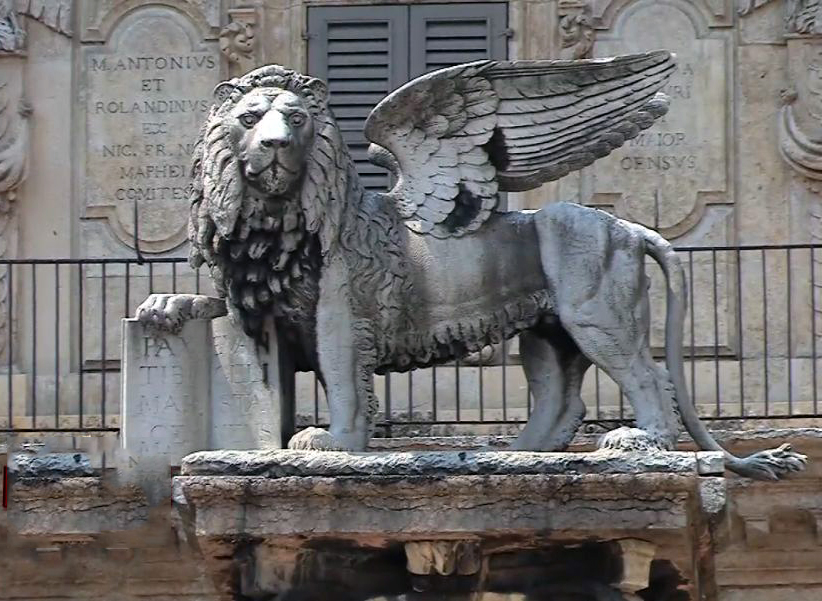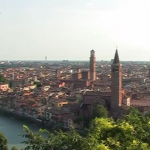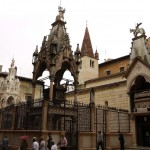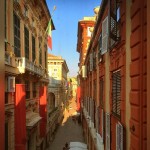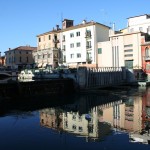A sightseeing tour in the city centre
Verona, a sightseeing tour
Do you know what Scaliger Tombs are?
There is a privileged panoramic view point where catching an entire city at a glance in every place in the world. The best view point in Verona is from Piazzale Castel San Pietro, on a hilltop behind the Roman Theatre. The first pre-roman community in Verona was founded here because of its position, suitable to fortifications. Verona was founded by the Gauls and the Venetians, as Polibio and Plinio wrote. I heard this story from my friend Luigi Pellini, author of a book about this topic.
Then the Romans arrived, requiring this land. They noticed that this area is perfectly sheltered by a bend in the Adige river which makes a natural protection, just like a water wall surrounding the city. They reclaimed the level ground and founded the Roman city, perfectly geometric. Because of its geographic position, Verona has become soon a very important point of communication: the junction between Via Gallica and Via Postumia, connected both east-west and north-south of Italy. Nowadays the road that runs from Brennero to Bologna, Florence and Rome crosses here the one that runs from Turin and Milan to Venice and Trieste.
From its foundation, Verona has grown so well-proportioned that the city planning has been declared UNESCO World Heritage. We can easily understand why looking at Verona from Monte San Pietro.
The whole history in a square
The touristic guide Sara Parisi leads me to Piazza delle Erbe, where we can find traces of the whole history of Verona from its origin down to the present day.
Piazza delle Erbe is the ancient Roman Forum. Looking up, there is Lamberti Tower: its base is from the first Medieval period (1.000 b.C.), while the tower was finished in the 1450 and it represents the whole period of the medieval lordships to the Renaissance. Next Verona had been governed by the Scala family lordship: just in front of Lamberti Tower there is Gardello Tower, commissioned by the Scala family. The fountain in the middle of the square was built by putting together roman ruins and more recent sculptures, for example the sculpture of Madonna Verona, the symbol of the city.
During a difficult period Verona had to ask Venice for help: this is represented by the Lion of San Marco on the column, overlooking everything around. Moving forward in the square, a sort of platform with an iron lasso takes us back again to the Middle Age. Don’t take this iron lasso for a pillory collar, it was just the unit of measurement to measure the bundle of wood and cereals. On the walls of this platform there are also the unit of length and the measure of bricks and shingles applied in Verona. Now as then, the open air market takes place here all around. In the past it was most of all a fruit market, now it is a touristic market. You can still find some fruit, but peeled, cut and beaten, ready to be sold to thirsty tourists. The power of supply and demand.
If you take a look to the side, there are amazing 16th century frescoed houses, by that time Verona was called urba picta (frescoed city). Mazzanti Houses were the Scala Family’s warehouses, where Mastino was murdered. On the other side of the square, there are some high and tight houses, symbol of the old Jewish ghetto opened by Napoleone. The statue just in front represents the writer Alberto Barbarani, a venetian dialectal poet, friend of the roman Trilussa and the Bolognese Testoni: thanks to him that part of the city has been preserved.
Last but not least the rib of a whale hung under the vault at the entrance of Piazza dei Signori, it is the symbol of the Corporazione degli Speziali & Farmacisti (Druggists guild).
History of Scaliger Tombs
In Piazza dei Signori you can admire the famous gothic Scaliger Tombs. During the 14th century these tombs were the funeral monuments for the leading spokespersons of the Scala family: Cangrande, Mastino and Cansignorio. All their names remind to dog names in Italian language and this assonance made people to think of the inhabitants of Verona as magnagati (cat swallowers)! Sara gives me another explanation: at that time “The Travels of Marco Polo” was a bestseller, in his book Marco Polo tells about the Gran Khan as a symbol of power, so the Scala family would have chosen the dog as a symbol of their nobility and loyalty to the Emperor (“dog” in Italian sounds like “Can, Khan”).
Enjoy a walk down Via Sottoriva, a street near the Adige river full of taverns. From the balustrade you can see Ponte Pietra, built by the Romans, and then Castel San Pietro! The place we started from! Our tour of Verona is over, but we have to visit at least two other undeniable places…
Main pic courtesy of Jose Gonzalez (Flickr user Jsh_Madrid)
Visit Verona: helpful hints
Arrival
For international flights there is the Verona Airport, connected to the city centre by bus (rides every 20 minutes, 6€, it takes 15 minutes). The nearest airport for transcontinental flights is Bologna Airport. From the airport, first you have to reach Bologna Central Station by bus (rides every 15 minutes, it takes 30 minuts, 6€). Then either Trenitalia and Italo trains reach Verona in 50 minutes, prices change according to class and services.
Transports
Walking is the best way to visit Verona. Anyway you can move by bus, a single ticket costs 1,3€ and it lasts 90 minutes. For more information check the ATV website.
What to do
Verona, the city of love, is in the North Eastern Italy and it is a UNESCO World Heritage Site.
Known wordlwide to be the city of Romeo and Juliet, by William Shakespeare, here you can visit Juliet’s House with the iconic balcony (“O Romeo, Romeo, wherefore art thou Romeo?” – that one). But Verona is famous even more for the Arena di Verona, that is basically the greatest Opera theatre in the world! Check the official website of the Arena for the shows calendar, don’t miss the opportunity to attend a concert sit on this Roman masterpiece (Summer only, of course. No roof, above is only sky, you know). Watch Italia Slow Tour web serie about the city of love.
Last, but not least, Verona is also near the lake Garda, the largest lake in Italy (it takes 30 minutes to Peschiera del Garda or Lazise, 4o minutes to Bardolino, by car).

